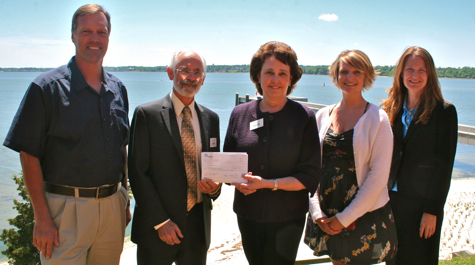Dominion funds underwater video system at VIMS
High-tech tool will allow for imaging of blue crabs on oyster reefs
The Dominion Foundation, the philanthropic arm of Dominion Resources, Inc., has donated $50,000 to the Virginia Institute of Marine Science for purchase of an underwater video system for field studies in Chesapeake Bay.
The first use of the multi-camera system will be to quantify the number and behavior of blue crabs and other mobile predators foraging on restored oyster reefs—an important measure of the success of reef restoration. The first deployment of the system is scheduled for later this summer or fall.
The video system—which can be deployed for weeks at a time with multiple options for lighting, image capture, and image retrieval—will be operated by professor Rom Lipcius and doctoral student Allison Colden, as well as other graduate students in the labs of Lipcius and professor Rochelle Seitz.
Lipcius says, “We’ve long had a need for a way to acquire high-quality video images from nursery and foraging habits within the Bay, where light and visibility are often limited. We’re very excited about the opportunities provided by the Dominion Foundation’s generous gift.”
Pamela Faggert, Vice President and Chief Environmental Officer of Dominion Resources Services, Inc., says “VIMS is a great resource for all of us who care about the Bay and for our marine resources in Virginia. We are pleased to make this donation that will help move that work forward and ultimately protect our environment and better manage fisheries in the Bay.”
 Lipcius says the video system will provide unprecedented access
to the behavior of marine animals in natural and artificial oyster reefs, seagrass
meadows, beds of macroalgae, and other Bay habitats where the water is often clouded
by high levels of suspended sediments and blooms of marine algae.
Lipcius says the video system will provide unprecedented access
to the behavior of marine animals in natural and artificial oyster reefs, seagrass
meadows, beds of macroalgae, and other Bay habitats where the water is often clouded
by high levels of suspended sediments and blooms of marine algae.
“The new system will allow us to observe these habitats for a much longer time than we can with SCUBA, and won’t impact the behavior of crabs and fishes nearly as much,” says Lipcius. The system employs a multi-spectral illumination system that uses combinations of infrared, red, and green light to minimize the camera’s impact on animal behavior.
First Deployment
Colden plans to deploy the video system this fall in the Great Wicomico and Lynnhaven rivers. These are tributaries of Chesapeake Bay where VIMS has partnered with the Army Corps of Engineers, the Virginia Marine Resources Commission, and other federal and state agencies to design and build artificial oyster reefs.
Colden says the system is unique in that, “It will allow us to directly quantify the presence and behavior of individual predators on oyster reefs, both during the day and at night, when many of these predators are most active.”
She says this information will help gauge and define the success of restored reefs. “Videotaping with this autonomous unit will help us determine how successful these reefs are in providing services that were once provided by natural oyster reefs in the Bay — whether it’s habitat for prey species or transfer of energy up the food chain. These are important ecosystem services that reefs provide to the shallow-water community.”
Lipcius plans to purchase the video system within the next month. It will be custom manufactured as part of the Fieldcam line offered by Fuhrman Diversified, Inc. of Seabrook, Texas. The company has custom built more than 700 closed-circuit video systems for use in field studies, education, industry, and laboratory settings. Fuhrman video cameras are in use on all seven continents.
Lipcius says the video system can hold 1-terabyte of data on its hard drive, equal to 1,000 hours of standard definition video. Once the hard drive is full, the researchers will retrieve it and download the data to a server at VIMS for analysis. Selected footage will be available to other researchers and the public via the VIMS website and the Institute’s YouTube channel. Details on accessing the video footage will be available from VIMS this fall.
Dominion is one of the nation's largest producers and transporters of energy, with a portfolio of approximately 28,200 megawatts of generation. Dominion operates the nation's largest natural gas storage system and serves retail energy customers in 15 states. For more information about Dominion, visit the company's website at www.dom.com.


